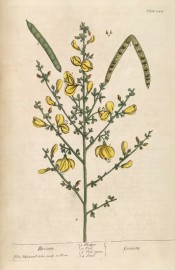Genista anglica L.
Fully-hardy, spiny deciduous shrub, sometimes procumbent, with small but showy, pea-like yellow flowers in spring and early summer. To 60cm. [RHSD, Hortus, Hilliers’].
Horticultural & Botanical History
Ancient garden plant. ‘Broom. Genista. The stalks grow about eight or ten foot high, the leaves are a dark green, and the flowers a bright yellow. It grows in fields and on commons, flowering in May. The stalks, flowers & seed are esteemed good to provoke urine & open obstructions of the liver and spleen. It is esteemed good for ye dropsy infused in common drink or ye ashes infused in wine, causing great discharges of water by urine. Some pickle ye flowers, before they are full blown, with salt & vinegar, and use them instead of capers, esteeming them good against diseases of the liver & spleen.’ [Blackwell pl.244/1737].
History at Camden Park
Listed in all published catalogues [T.514/1843].
Notes
Common broom today usually refers to Cytisus scoparius (L.) Link.
Published Dec 20, 2009 - 04:56 PM | Last updated Jul 21, 2010 - 12:03 PM
| Family | Fabaceae |
|---|---|
| Category | |
| Region of origin | Europe including Britain |
| Synonyms | |
| Common Name | Needle furze, Petty whin |
| Name in the Camden Park Record |
Genista Anglica - Common Broom |
| Confidence level | high |
